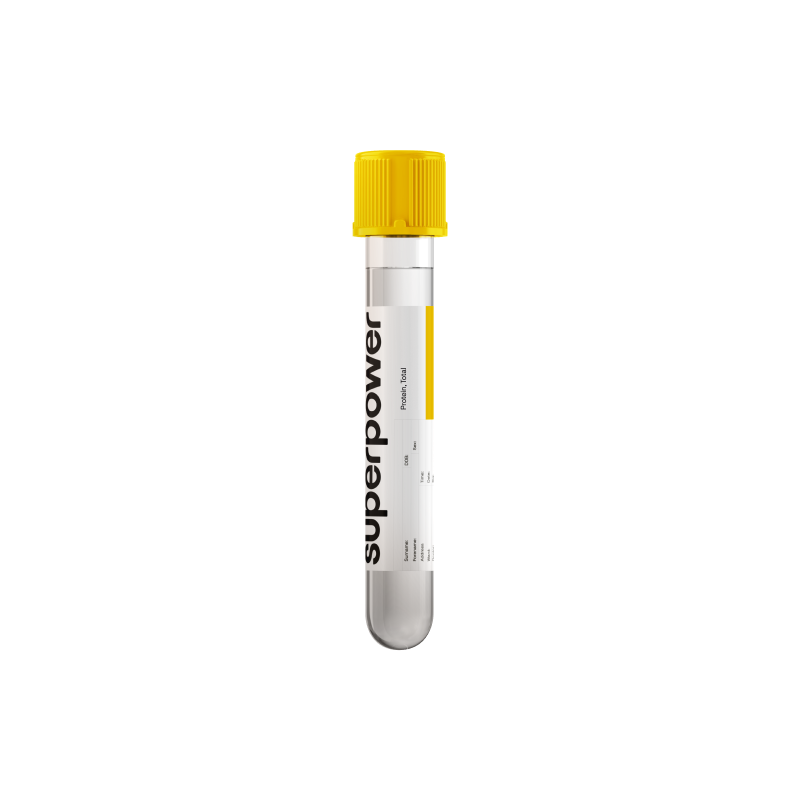Protein, Total testing provides a broad snapshot of how your body is making, using, and retaining proteins. It captures shifts related to hydration, inflammation, liver or kidney function, and immune health. Interpreting your result in context helps guide training, recovery, and overall wellbeing.
Key Benefits
- Check your overall blood protein to reflect nutrition, hydration, liver, kidney, and inflammation.
- Spot low protein that can signal poor intake, malabsorption, or liver disease.
- Flag high protein from dehydration, chronic inflammation, autoimmune disease, or abnormal antibody proteins.
- Clarify causes of swelling or fatigue by pairing with albumin and globulin levels.
- Guide next tests, like serum protein electrophoresis, when protein is high and unexplained.
- Support safe pregnancy care by recognizing expected dilutional lows in late pregnancy.
- Track recovery from illness or dehydration by trending proteins back toward baseline.
- Interpret results with albumin, liver panel, kidney tests, and your symptoms.
What is Protein, Total?
Protein, Total is the combined amount of all proteins dissolved in your blood, mainly albumin and a diverse group called globulins. Albumin is produced by the liver, while many globulins are made by the liver and by immune cells (B cells/plasma cells) as antibodies (immunoglobulins). Other tissues contribute specialized carriers and signaling proteins. This circulating mixture is built from amino acids derived from your diet and body stores and is constantly renewed as the body synthesizes and clears proteins.
Total protein captures the size of this working protein pool that keeps blood volume stable (oncotic pressure), transports hormones, lipids, minerals, and drugs, buffers acid–base shifts, and supports host defense through antibodies and other protective proteins. As a single number, it reflects the balance between protein production, distribution, and loss. It serves as a broad window into the body’s capacity for transport, immunity, and fluid homeostasis, without pinpointing any one protein or function.
Why is Protein, Total important?
Protein, Total reflects the sum of albumin and globulins in your blood—the body’s transporters and defenders. It captures liver synthetic capacity, immune system activity, and fluid balance (oncotic pressure). Because nearly every organ relies on these proteins to move hormones, vitamins, and drugs, and to keep fluid inside blood vessels, this single number offers a whole‑body snapshot.
Most adults sit within a tight, stable range, with optimal values tending toward the middle. Similar ranges apply to men and women. Children may run slightly lower. During pregnancy, values often dip modestly because plasma volume expands and dilutes proteins.
When the number is low, it usually means reduced production, increased loss, or dilution. The liver may be struggling to make albumin; the kidneys or gut may be losing protein; or overall intake/absorption may be inadequate. People may notice ankle swelling or puffiness (from low oncotic pressure), fatigue, muscle loss, slow wound healing, brittle hair or nails, and more frequent infections if immune globulins are low. In children, poor growth can emerge. Pregnancy commonly lowers values a bit; larger drops can signal added protein loss.
When the number is high, dehydration is common, concentrating proteins. Less often, immune globulins rise with chronic inflammation, persistent infection, autoimmune disease, or a monoclonal protein. Symptoms can include thirst and dry mouth with dehydration, or headaches and fatigue when blood becomes more viscous; kidneys may be stressed.
Big picture: Total protein links nutrition, liver function, kidney and gut integrity, hydration, and immune status. Persistent abnormalities point to upstream system issues and, over time, relate to risks such as edema, infection susceptibility, or organ strain, and are interpreted alongside albumin, globulins, and the A/G ratio.
What Insights Will I Get?
Protein, Total measures the combined concentration of albumin and globulins in the blood. It reflects the body’s protein reservoir for fluid balance (oncotic pressure), transport of hormones and minerals, immune defense (immunoglobulins), and repair. At a systems level it integrates liver synthetic capacity, nutrition, hydration status, and immune activity.
Low values usually reflect reduced production, increased loss, or dilution. This occurs with limited protein synthesis in the liver, protein losses through kidneys or gut, major skin loss (burns), or excess body water (hemodilution). System effects include a tendency to fluid shift and swelling (low oncotic pressure), less transport of key molecules, slower healing, and, if globulins are low, reduced antibody defenses (hypogammaglobulinemia). Values are commonly lower in late pregnancy due to plasma volume expansion, and reference ranges are lower in infants and young children.
Being in range suggests adequate liver protein synthesis, sufficient dietary protein intake and absorption, balanced immune protein production, and stable hydration. For most adults, optimal tends to sit around the mid-range where albumin and globulins are in proportion.
High values usually reflect concentration of the blood from dehydration (hemoconcentration) or increased globulin production from chronic immune stimulation or a monoclonal protein (gammopathy). System effects can include thicker serum and a signal of ongoing inflammation or clonal plasma cell activity; albumin may be normal or low while globulins drive the rise.
Notes: Interpretation depends on albumin, calculated globulin, and the albumin-to-globulin ratio, and may be clarified by serum protein electrophoresis. Serum values (no fibrinogen) differ slightly from plasma. Hydration, posture, tourniquet time, acute illness, IV fluids, pregnancy, and age shift results.



.svg)



.png)
.png)
.png)
.png)








